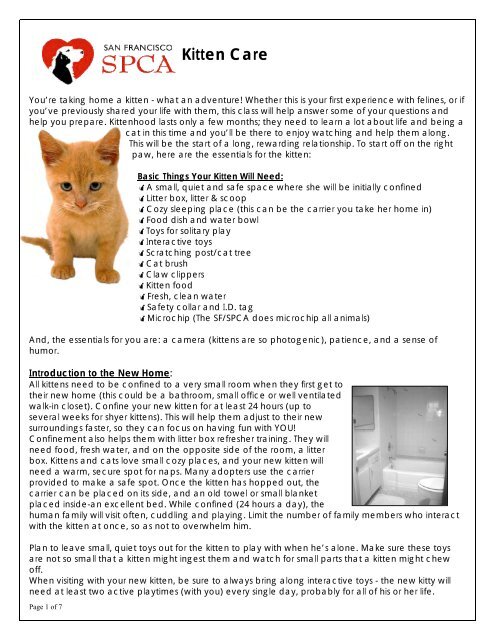Kitten Kindergarten - San Francisco SPCA
Kitten Kindergarten - San Francisco SPCA
Kitten Kindergarten - San Francisco SPCA
Create successful ePaper yourself
Turn your PDF publications into a flip-book with our unique Google optimized e-Paper software.
<strong>Kitten</strong> Care<br />
You’re taking home a kitten - what an adventure! Whether this is your first experience with felines, or if<br />
you’ve previously shared your life with them, this class will help answer some of your questions and<br />
help you prepare. <strong>Kitten</strong>hood lasts only a few months; they need to learn a lot about life and being a<br />
cat in this time and you’ll be there to enjoy watching and help them along.<br />
This will be the start of a long, rewarding relationship. To start off on the right<br />
paw, here are the essentials for the kitten:<br />
Basic Things Your <strong>Kitten</strong> Will Need:<br />
A small, quiet and safe space where she will be initially confined<br />
Litter box, litter & scoop<br />
Cozy sleeping place (this can be the carrier you take her home in)<br />
Food dish and water bowl<br />
Toys for solitary play<br />
Interactive toys<br />
Scratching post/cat tree<br />
Cat brush<br />
Claw clippers<br />
<strong>Kitten</strong> food<br />
Fresh, clean water<br />
Safety collar and I.D. tag<br />
Microchip (The SF/<strong>SPCA</strong> does microchip all animals)<br />
And, the essentials for you are: a camera (kittens are so photogenic), patience, and a sense of<br />
humor.<br />
Introduction to the New Home:<br />
All kittens need to be confined to a very small room when they first get to<br />
their new home (this could be a bathroom, small office or well ventilated<br />
walk-in closet). Confine your new kitten for at least 24 hours (up to<br />
several weeks for shyer kittens). This will help them adjust to their new<br />
surroundings faster, so they can focus on having fun with YOU!<br />
Confinement also helps them with litter box refresher training. They will<br />
need food, fresh water, and on the opposite side of the room, a litter<br />
box. <strong>Kitten</strong>s and cats love small cozy places, and your new kitten will<br />
need a warm, secure spot for naps. Many adopters use the carrier<br />
provided to make a safe spot. Once the kitten has hopped out, the<br />
carrier can be placed on its side, and an old towel or small blanket<br />
placed inside-an excellent bed. While confined (24 hours a day), the<br />
human family will visit often, cuddling and playing. Limit the number of family members who interact<br />
with the kitten at once, so as not to overwhelm him.<br />
Plan to leave small, quiet toys out for the kitten to play with when he’s alone. Make sure these toys<br />
are not so small that a kitten might ingest them and watch for small parts that a kitten might chew<br />
off.<br />
When visiting with your new kitten, be sure to always bring along interactive toys - the new kitty will<br />
need at least two active playtimes (with you) every single day, probably for all of his or her life.<br />
Page 1 of 7
While the kitten is confined is the perfect time to start her acclimation to your schedule-as much as<br />
possible with cats. Have a good long playtime immediately before you go to sleep so the kitten will<br />
be tired and more likely to sleep during the night. If the kitten meows at night, unless<br />
you feel that it is hurt or ill, ignore it. It can sometimes take days before they learn<br />
not to cry at night, and if you go in to visit, it will reinforce the attention seeking<br />
behavior.<br />
Finally, until the kitten is self-confident enough to feel at home with everyone in<br />
your home and the home itself, confine him to a single room (with litter box, etc.)<br />
while you are not there to supervise him.<br />
Cat Carrier:<br />
Your kitten will need a sturdy plastic carrier, large enough to give her room even when she is full<br />
grown. (A cardboard one will work for a few visits, though.) To get her used to<br />
the carrier, leave it out and open in the house, and put a few food treats<br />
inside. This will help her associate it with good things, and she will be less<br />
fearful of it. When it is necessary to take her to the vet, it is a good idea earlier<br />
in the day to entice her into a small room (with few hiding places), like a<br />
bathroom, let her settle there, and then take the carrier in there to place her<br />
into it. This will prevent having to chase your kitten to try to get her into her carrier.<br />
<strong>Kitten</strong> proofing & Safety:<br />
<strong>Kitten</strong>s, you will find, will play with anything-especially anything they can make move. That means<br />
that you will need to check your home out from a kitten’s viewpoint. Any electrical cords or wires<br />
should be bundled and hidden, because kittens are tempted to chew on them or<br />
pull out plugs. Plastic bags need to be kept away from the kitten (many cats are<br />
attracted to these bags and will eat them). <strong>Kitten</strong>s love to play in paper bags,<br />
but please cut the handles off first, so the kitten can’t get caught in them.<br />
String, yarn, rubber bands and ribbon are dangerous for cats as they will<br />
swallow them. The barbs on their tongues make it impossible for them to<br />
remove the string from their mouths once swallowed, and this can lead to costly<br />
surgery to repair the internal damage and save their lives. Look around for<br />
valuable, breakable objects that your kitten might knock over and be<br />
prepared to put them away until your kitty mellows.<br />
And, finally, while the kitten is still confined, make sure there are no tiny<br />
places where he could run if frightened, and hide, and then be difficult<br />
to find. Plan to block access to those kinds of spaces, especially behind<br />
stoves, refrigerators, etc. Recliner chairs, motors, washers and dryers are<br />
very dangerous places that kittens may try to hide in, too. Then there<br />
are windows and doors. No matter what you might have heard about<br />
cats falling from windows and surviving, that doesn’t happen often.<br />
Most do not survive or are very badly injured. Making certain that a<br />
kitten cannot insert a paw into the window and push it open, and<br />
making certain that you have tight fitting screens in any open window<br />
(even if only open an inch!) is very important. Cats should never have<br />
access to an open, unprotected window.<br />
Some household plants and flowers are poisonous to cats. There are lists<br />
available on the internet as well as through The SF/<strong>SPCA</strong>. Human<br />
Page 2 of 7
medications, many cleaning solutions and anti-freeze are also very poisonous to cats. These must all<br />
be put away where the kitten cannot get at them - and they do have agile little paws. You can use<br />
cupboard latches used to baby-proof kitchens to keep your kitten away from these items.<br />
Keeping Your <strong>Kitten</strong> Indoors:<br />
Indoor cats live longer, healthier lives than those who are allowed to go<br />
outdoors. Just as responsible parents do not let their children play in the<br />
street, responsible pet guardians don’t allow their pets to, either. Feline<br />
Leukemia (FELV) and Feline Immunodeficiency Virus (FIV) are two<br />
major illnesses contracted through contact with other cats. Cats<br />
involved in fights with other cats, dogs, raccoons, or other animals<br />
often are badly injured, and require expensive medical care.<br />
Additionally, many cats are lost forever, too frightened to find their way<br />
home, and may even starve to death. And, although some folks<br />
believe it, cats are not “street smart”. A car means little to a cat, and<br />
they do not instinctively know to run from one. A cat-proof enclosure in<br />
your back yard can allow your cat some safe, outdoors time.<br />
Regardless, even in the safest of situations, kittens should never be let<br />
outside until over the age of 6 months, and only if they have had all the<br />
appropriate shots.<br />
Preventing Escapes:<br />
<strong>Kitten</strong>s can move quickly, and they may be tempted to dart out your<br />
door if given the chance. First of all, make sure not to leave your doors to<br />
the outside open for longer than necessary for you to get in or out! This is<br />
something that needs to be discussed with all members of an active<br />
household (such as a multi-roommate situation, or a home with children<br />
or children who visit often) so everyone understands the danger of<br />
escape. Cats and kittens are easily frightened and overwhelmed when<br />
out of their safe territory, and may panic and hide, or worse, bolt into the<br />
street.<br />
Establish an area away from the door as your “Goodbye and Greeting<br />
Zone.” Before you leave, and when you get home, give your cat a treat<br />
in this area.<br />
Entertaining:<br />
Until your kitten is acclimated and comfortable in the house, large parties, or noisy groups of people<br />
will just frighten him. If you do plan a gathering, it is best to confine the kitten to one room, with food,<br />
water, litter box and toys, and perhaps bring guests, (a few at a time), to meet him. Holidays are<br />
particularly stressful for many cats as are fireworks - your kitten might want to hide then. We do not<br />
recommend adopting a kitten during holidays - they, and you, will have a better chance of settling in<br />
when it is quiet and stable in your home.<br />
Page 3 of 7
Socialization:<br />
<strong>Kitten</strong>s are very tiny, and even though very active and athletic, they are<br />
fragile! That means, handle with care, but definitely handle them! The more<br />
consistent, gentle petting they receive, the more social they will become. Plan<br />
to spend two or three sessions every day handling and petting your kitten,<br />
even talking to him or her-most cats and kittens respond to quiet talk. Gentle<br />
petting all over their bodies (including the ears and mouth) will help them feel<br />
comfortable when the veterinarian needs to exam them. Likewise, massaging<br />
toes and paws will make them more at ease when claw-clipping time comes.<br />
Like human babies, kittens need lots of nap time, so do not bother them when<br />
they’re sleeping, but let them get their rest. If your kitten is squirming when you<br />
pick her up, do not force her to be held. Instead, let them continue to explore when they start to<br />
squirm - just plan to have more frequent, brief cuddle sessions. Do not allow anyone to “over-pet” the<br />
kitten-especially on tummies and backs-the kitten may respond by nipping or swatting. Being<br />
handled this way is very uncomfortable for the kitten and is often perceived as being threatening.<br />
And, no one wants to have their kitten get in the habit of nipping or of<br />
having a kitten who is frightened of human hands.<br />
Ideally, when you have quiet guests visit, introduce them to the kitten -<br />
getting to know a lot of people will help the kitty understand that visitors<br />
are okay. But, again, don’t force the issue. Luring the kitten to interact with<br />
a toy on a wand or stick, and letting the kitten come to the guests is the<br />
best plan. Exposing the kitten to both men and women is a good idea,<br />
too, as some kittens become fearful around people who are larger, or<br />
have deeper voices, or a higher pitched voice, due to lack of exposure to<br />
different people. These socialization times will have a long term impact on<br />
both the kitten and the family. <strong>Kitten</strong>s need a lot of affection and<br />
interaction from their family.<br />
Parents must be willing to supervise children’s interaction with the kitten and teach them how to<br />
safely, respectfully and appropriately handle the kitten.<br />
Playtime:<br />
<strong>Kitten</strong> playtime looks like just that-play. It is actually training for the hunting skills that are so natural to<br />
most cats: pouncing, running, stalking, ambushing and climbing. It is for this reason that they so enjoy<br />
bird-like or rodent-like toys-they think they are going after prey. Each play session should last 15-20<br />
minutes - or longer for the very athletic kitties. All cats and kittens like play, but some need more than<br />
others.<br />
<strong>Kitten</strong>s generally need lots of interactive playtime and will continue to need<br />
play as<br />
they grow into adults. It is essential that you never play with the kitten with<br />
your hands or “roughhouse” with the kitten. This includes wiggling fingers to<br />
entice the kitten to attack or wrestling with her. Also, holding a small mouse<br />
or ball type toy in your hand and wiggling that can also lead the kitten to<br />
think your hand is a toy. Cats need to understand that hands are for gentle<br />
petting, and only toys are for playtime. A grown cat who hasn’t learned to differentiate<br />
between toys and hands will not be a safe companion. With consistent treatment from<br />
everyone the kitten will learn to trust humans and you’ll all enjoy his playtime. If you have been<br />
playing with interactive toys, remember to take the toy with you when not playing. These toys<br />
can be dangerous if the cat is left alone with it, because they may try to eat them. Also plan to<br />
purchase or make a variety of interactive toys- like humans, cats get bored with the same old thing.<br />
<strong>Kitten</strong>s who do not have the stimulation of playtime and petting will likely be shy and withdrawn and<br />
never develop their complete personalities. Even though they are so small, kittens are nearly as agile<br />
Page 4 of 7
as adult cats, and will do amazing things going after toys. For more information, read<br />
“How to Play with Your Cat” available in the Cat Behavior Library at www.sfspca.org<br />
Although they are likely to be most active in the morning and evening, you will<br />
probably hear a lot of midnight madness, too. <strong>Kitten</strong>s sleep a lot, and they need<br />
it, but they may well tear around the house at night, attacking imaginary foes.<br />
This is normal kitten behavior, and not something to be concerned about<br />
unless it happens very often. Again, a lengthy play session before bedtime<br />
may help with this behavior.<br />
<strong>Kitten</strong> Energy:<br />
<strong>Kitten</strong>s will be curious about everything. They will fly around the house, seeming to chase nothing at<br />
all, or will stare at a spot on the wall-until everyone else is staring, too, wondering what we are all<br />
looking at. Their senses of smell and hearing are far superior to ours, and they may hear insects or<br />
mice inside the walls.<br />
Routine:<br />
All cats thrive on routine in their lives – they like stability and knowing when they can<br />
anticipate feeding, playtime and attention which all helps reduce stress. We recommend<br />
that anything that can be done on a schedule, such as feeding, playtime, affection, and<br />
grooming, happen at around the same time(s) each day.<br />
Positive Reinforcement:<br />
Punishment never works with cats - they are busy being cats and kittens-their behavior is cat<br />
behavior, not human behavior. That’s what makes them such fun! They do not understand<br />
being punished for just being themselves.<br />
Punishment will cause them to be fearful and neurotic, and possibly lead to aggressive behaviors<br />
such as swatting and biting. Yelling at a kitten or chasing it will further terrify her. Using positive<br />
reinforcement for good behavior is far more likely to have the desired effect. If a kitten nips or swats,<br />
it is best to just stop whatever is going on at the time and say “no” or “ouch” in a high pitched voice –<br />
just enough to startle the kitten. Then after a 15 second “time-out”, you can allow some playtime<br />
with an interactive toy. If the reward comes too soon, kitty will soon be swatting you every time she<br />
wants to play. Please see “Just say No, Cats and the Crime of Punishment?” Available in the Cat<br />
Behavior Library at www.sfspca.org<br />
Litter box:<br />
It is best to have at least one litter box per cat, and ideally one extra. We<br />
suggest regular unscented clay litter. For particularly small kittens, a box with<br />
lower sides may be necessary, at least until they grow a bit more, so they<br />
can climb in easily. Veterinarians recommend not using clumping litter for<br />
kittens, as they tend to ingest too much of it when grooming themselves,<br />
which can cause a deadly intestinal blockage. Keep the litter box<br />
immaculately clean, and in a safe, quiet spot where the kitten will have privacy. Many litter box<br />
problems occur because the cat does not feel safe using the box or the litter box is not kept clean<br />
enough. Start off right away by keeping the kitten’s “bathroom” immaculate. For more information<br />
on litter box training see “Litter Box Basics” available in the Cat Behavior Library at www.sfspca.org<br />
Page 5 of 7
Cat Tree or Scratching Post:<br />
All cats need to scratch, as it keeps their muscles and claws in shape and is a stress<br />
releaser. We recommend that you purchase or make a cat tree or scratching post. It<br />
needs to be tall enough and heavy enough that they can grow into it – so that when<br />
an adult cat stretches full length it cannot knock the post over. Many cats have a<br />
preference as far as texture goes: cat trees with both sisal rope and carpeting can<br />
help satisfy your kitten’s needs. You will need to encourage your kitten to scratch<br />
on its scratching post. For more information, see “Teaching Your Cat to Use a<br />
Scratching Post” available in the Cat Behavior Library at www.sfspca.org<br />
Claw Clipping:<br />
Cats’ claws need to be clipped regularly. We recommend you use a clipper designed for that<br />
purpose, they are available at pet supply stores. Routinely<br />
clipping claws on your kitten will help him be more accepting<br />
of it as he grows up. We have a Cat Claw Clipping Clinic<br />
twice a month at the Leanne Roberts Center at 201<br />
Alabama Street. Call 554-3030 for details!<br />
Grooming:<br />
Even though they are known to be very clean and tidy animals, cats do have a lot of<br />
fur, and they will shed. Brushing and combing are excellent ways to bond with<br />
your kitten as well as keeping all that fur under control. Many cats can’t keep<br />
up with their own grooming, and brushing will help eliminate fur balls. Soft<br />
to medium bristle brushes are best, and again, starting while they are<br />
young, and grooming them regularly is best. Many cats enjoy being<br />
brushed, but you might need to make this more fun by giving a treat<br />
when grooming. This is also one of the best ways to deal with fleas on<br />
kittens-use a flea comb, and comb regularly. Flea collars are not the<br />
best way to deal with the problem, so if you do find<br />
fleas on your kitten, continue to comb and check<br />
with your vet for the best, safest solution.<br />
Food and Water:<br />
Each cat in the household needs its own food dish, and some will be willing to share water bowls. Be<br />
aware of how much food your kitten eats as it is essential that they eat well – they are growing a lot<br />
at this point in their lives! Discuss feeding issues with the veterinarian on your first visit.<br />
If you have multiple cats it is best to separate their food dishes by at least 18”. Since<br />
a kitten will need to be fed kitten food, adults and kittens should be fed separately.<br />
And, no milk, cats don’t need it, and in fact many cats are made ill by drinking it.<br />
Page 6 of 7
Medical Concerns:<br />
<strong>Kitten</strong>s and cats hide illness very well, so it is important to watch carefully for signs of illness. Some<br />
things to notice: Is the kitten eating, drinking and using the litter box regularly? Is he lethargic when<br />
he’s<br />
usually very energetic? Does his fur coat look less healthy, and is he<br />
grooming himself routinely? Does the kitten strain or cry when using the<br />
litter box? Does he have diarrhea (which can be very serious when<br />
prolonged in kittens)? Is he sneezing or does he have watery eyes?<br />
Is he shaking his head a lot, or scratching at his ears? Since kittens<br />
can become ill quickly, any of these signs can mean it is time to<br />
contact the vet.<br />
Visits to the Veterinarian:<br />
All cats should have annual checkups with the vet. <strong>Kitten</strong>s, who<br />
need extra immunizations, will need to go to the doctor more<br />
often at first. Many illnesses can be detected in their early stages<br />
with these annual visits. Ask your vet to explain what symptoms to<br />
look for related to common illnesses. Be prepared, too, for<br />
emergencies. Have the name of emergency veterinary services<br />
handy, and know how to get there in a hurry if necessary.<br />
Multi-Cat Households:<br />
If there are other cats in the household, a slow introduction is very important. Keep in mind the size<br />
difference between the kitten and any adult cats. They might enjoy playing<br />
together, but the larger cat might inadvertently injure the kitten so they need<br />
to be watched carefully. Don’t be surprised to see your kitten become the<br />
more dominant kitty in the household as he or she grows older, bigger and<br />
stronger. For more information see our “Cat-to-Cat Introduction<br />
Protocol” available in the Cat Behavior Library at<br />
www.sfspca.org<br />
And finally…<br />
Have a wonderful, long life with your new companion. You will find that sharing your life with a cat is<br />
a never ending source of unconditional love and wonder. Cats will continue to surprise and delight us<br />
all of their lives. They give so much back in return for the care we give them! Enjoy your little tiger -<br />
who in most ways is just a very tiny version of his very large wild relatives.<br />
For more information about cat behavior please visit www.sfspca.org<br />
Page 7 of 7
From the <strong>San</strong> <strong>Francisco</strong> <strong>SPCA</strong> Cat Behavior Program<br />
A BOOK LIST FOR CONSCIENTIOUS CAT OWNERS<br />
The following selection of books will give you a good overview of our feline friend, the<br />
domestic cat. You will find different ideas and opinions, but the basics of these particular<br />
books should give you a wonderful foundation for understanding the inside and outside of<br />
your cat.<br />
1. Think Like a Cat: How to Raise A Well-Adjusted Cat, Not a Sourpuss, by Pam<br />
Johnson-Bennett. A comprehensive book which covers basic health care and<br />
behavior, as well as behavior modification techniques to solve problem behaviors.<br />
2. Twisted Whiskers: Solving Your Cat’s Behavior Problems, by Pam Johnson-<br />
Bennett. Another good book by Pam Johnson on cat behavior. “Johnson’s catfriendly,<br />
no-nonsense techniques glow with common sense and insight…a practical<br />
guide and an inspiration.” (quote from The Crossing Press).<br />
3. The Cat Who Cried For Help, by Dr. Nicolas Dodman. He advocates the use of<br />
drug therapy a little more than most behaviorists, but also talks about the<br />
behavioral modification steps that can be used without medication, or in conjunction<br />
with medication.<br />
4. Know Your Cat: An Owner’s Guide to Cat Behavior, by Bruce Fogle, DVM. This<br />
book has outstanding photographs documenting cat behavior.<br />
5. The Cat’s Mind: Understanding Your Cat’s Behavior, by Bruce Fogle, DVM. More<br />
in-depth text on cat behavior.<br />
6. The New Natural Cat: A Complete Guide for Finicky Owners, by Anitra Frazier.<br />
This book is a “must” for every cat owner. The author covers issues not commonly<br />
written about including how to pill a cat easily, grooming tips, and nutritional advice.<br />
For more information about Cat Behavior<br />
Visit www.sfspca.org<br />
Want to know more? Read “Litter Did You Know”, the official Cat Behavior Blog of<br />
the <strong>San</strong> <strong>Francisco</strong> <strong>SPCA</strong><br />
www.sfspcacat.blogspot.com<br />
G:\Adoption\Adoption\Forms and Procedures\Adoption Packet Handouts\Cat Adoption Packet updated 04/23/09
CAT FEEDING SCHEDULE<br />
This is what your new cat has been eating here at The SF/<strong>SPCA</strong>. We suggest keeping the same<br />
diet in the beginning to avoid stomach troubles. When changing the diet, do so gradually<br />
to avoid digestive upset. Remember to always have fresh water (not milk) available for your<br />
cat.<br />
<strong>Kitten</strong>s (until 6 months old) receive the following Wet & Dry food in separate dishes<br />
• 1/3 cup of Purina One kitten dry - twice a day PLUS<br />
• 1/2 can of Purina Fancy Feast kitten wet (3 oz. can) - twice a day<br />
Adult Cats (6 months and older) receive the following Wet & Dry food in separate dishes<br />
• 1/2 cup of Purina One cat dry - once a day<br />
OR 1/4 cup - twice a day<br />
• 1/4 can of Purina Friskies Chicken and Liver wet (6 oz. can) – twice a day<br />
Please consult your own veterinarian for your pet’s long term nutritional needs.<br />
updated 9/3/09
The <strong>San</strong> <strong>Francisco</strong> <strong>SPCA</strong> Cat Behavior Program Presents<br />
Cat Claw Clipping Clinic<br />
Come Deal with those daggers!<br />
The Cat Behavior Program is offering Nail Trimming twice a month for your<br />
favorite feline(s)<br />
1 st Sunday of Each Month<br />
10am – 11am<br />
Location:<br />
Spay/Neuter Clinic in the<br />
Leanne B. Roberts Animal Care<br />
Center<br />
201 Alabama Street, just around the<br />
corner from the main SF/<strong>SPCA</strong> building<br />
on 16 th Street.<br />
3 rd Sunday of Each Month<br />
10am – 11am<br />
Location:<br />
Spay/Neuter Clinic in the<br />
Leanne B. Roberts Animal Care<br />
Center<br />
201 Alabama Street, just around the<br />
corner from the main SF/<strong>SPCA</strong> building<br />
on 16 th Street.<br />
$20 flat fee for all claws.<br />
Please bring all cats in carriers – cats without a carrier or in a trap will not be accepted.<br />
For information: (415)522-3525<br />
Get your cat’s nails trimmed and help support the cats and dogs at the SF/<strong>SPCA</strong>!
Frequently Asked Medical Questions<br />
Has my dog or cat had all of their vaccinations?<br />
We have provided basic vaccinations appropriate for the age of your new<br />
companion. Depending on your area and lifestyle your veterinarian may advise<br />
additional vaccinations. Puppies and kittens receive vaccinations in a series.<br />
It is important for you to contact your veterinarian and complete this series.<br />
The vaccinations we provide for cats and kittens are appropriate for an<br />
indoor only lifestyle. If you plan to let your cat outside please inform your<br />
veterinarian and plan on additional vaccinations. Be advised that cats allowed outdoors are at risk<br />
for a variety of diseases and dangers.<br />
Do you guarantee my new companion is free of fleas and worms?<br />
No. We have given your new cat or dog a worming treatment and a flea treatment but we cannot<br />
guarantee this was 100% effective. Speak with your veterinarian if you suspect worms or fleas and<br />
to arrange regular parasite control. Any further treatments for fleas or worms are not covered by the<br />
SF/<strong>SPCA</strong>.<br />
Why should I take my new companion to a veterinarian right away, didn’t you<br />
check her out thoroughly?<br />
All of our animals receive a basic health evaluation before adoption given by an animal technician.<br />
Unless your animal appeared ill during her stay, she might not have received a complete<br />
examination by a veterinarian. The SF/<strong>SPCA</strong> offers no guarantee that the animal you have adopted<br />
is 100% healthy. It’s important to get the opinion of a qualified veterinarian on the health of your new<br />
animal. Bring your new companion to your veterinarian for a thorough examination and discuss your<br />
lifestyle plans for your cat or dog so that your vet can tailor the proper vaccinations and parasite<br />
control. Your vet can answer your medical questions and advise you on general care and proper<br />
diet. Most <strong>San</strong> <strong>Francisco</strong> veterinarians offer this first visit FREE if used within 3 working days<br />
of the adoption date.<br />
What happens when my ShelterCare 30-day Gift of Insurance expires?<br />
Your coverage will lapse and you will be responsible for all charges incurred in relation to veterinary<br />
services after that time. We encourage you to call ShelterCare within the time frame listed on your<br />
policy document to obtain and additional 15 days of insurance at no extra charge. If you choose to<br />
continue with an insurance plan you will be able to protect your animal’s health and potentially save<br />
thousands of dollars over the life of your companion.
Important Medical Information<br />
Your adoption packet contains medical records for your newly adopted cat or dog. These records document all<br />
tests, vaccinations, and parasite treatments that were performed at the SF/<strong>SPCA</strong>. They also contain information<br />
about any illnesses or conditions that were diagnosed, what treatment was given, and what kind of follow up, if<br />
any, is recommended. Please take these records with you to your first introductory appointment with your private<br />
veterinarian. Your veterinarian may contact us at (415) 554-3030 if anything needs clarification. Most <strong>San</strong><br />
<strong>Francisco</strong> veterinarians offer a FREE “get to know you” visit within three working days of your adoption.<br />
Be sure to call a veterinarian today! (The SF/<strong>SPCA</strong> does not make veterinarian recommendations.)<br />
VACCINATIONS<br />
All animals are given basic vaccinations before being placed for adoption. Consult a veterinarian to determine<br />
whether additional vaccinations are indicated, and to determine a vaccination schedule for the future.<br />
<strong>Kitten</strong>s and puppies need a series of vaccinations to protect their health. (These are comparable to “booster<br />
shots” that children receive.) If you adopted a young animal, he or she may not have completed the series.<br />
Consult a private veterinarian to make sure that your new friend gets the entire series. Please note that puppies<br />
and kittens under four months do not receive heartworm or FELV tests, respectively.<br />
Cats are vaccinated by the SF/<strong>SPCA</strong> for an indoor-only lifestyle, as we recommend an indoor-only lifestyle to<br />
protect them from exposure to injury and disease. They are tested, but not vaccinated, for FELV/FIV. They are not<br />
vaccinated for rabies. If your cat may go outdoors in the future, s/he will need additional vaccines. Please<br />
discuss this with your veterinarian.<br />
Dogs over four months have been tested for heartworm and have been given basic vaccinations, including<br />
rabies. Dogs under four months cannot be vaccinated for rabies. The rabies vaccination is documented on your<br />
medical records, and this can be used as verification in order to obtain a dog license in your own county. <strong>San</strong><br />
<strong>Francisco</strong> residents who adopt dogs over four months receive a dog license at the time of adoption. Your<br />
veterinarian will determine whether your lifestyle, for example, plans to take the dog camping or hiking, requires<br />
that your dog receive additional vaccinations.<br />
FLEAS AND WORMS<br />
Fleas and worms are the most common parasites in dogs and cats. Our animals have received a treatment for<br />
fleas, if needed, and a treatment for worms; some animals require additional treatments. Please consult your<br />
veterinarian regarding additional parasite treatments and about establishing an ongoing preventative program for<br />
parasites, including heartworm.<br />
SF/<strong>SPCA</strong> DOES NOT COVER ANY FURTHER VACCINATIONS OR PARASITE TREATMENTS FOR YOUR<br />
NEWLY ADOPTED ANIMAL.<br />
ShelterCare 30-DAY GIFT INSURANCE COVERAGE<br />
If you provided us with your e-mail address, you will automatically receive an e-mail from ShelterCare Pet Health<br />
Insurance Company. Simply click on the link and you will be able to download all the pertinent information. The<br />
ShelterCare Gift commences 48 hours after adoption and provides $750 of coverage for treatment of any of the<br />
conditions listed below. A $75 deductible is applicable per policy.<br />
Accident Coverage: Foreign Body Ingestion Removal, Motor Vehicle Accident, Lacerations, Insect Bites/Stings,<br />
Defined Poison Ingestion, Bone Fracture<br />
Illness Coverage: Eye and Ear Illnesses, Flea Allergy Dermatitis, Intestinal Parasites, Urinary Tract Infections,<br />
Upper Respiratory Tract Infections, Mange/Mites/Ringworm, Parvovirus/Feline Panleukopenia, Tick Borne<br />
Diseases, Heartworm Disease.<br />
PLEASE NOTE THAT SHELTERCARE INSURANCE WILL NOT COVER TREATMENT FOR ANY<br />
PREEXISTING CONDITIONS.<br />
20% DISCOUNT AT THE SF/<strong>SPCA</strong> VETERINARY HOSPITAL FOR THE FIRST 30 DAYS AFTER ADOPTION<br />
We are pleased to be able to provide a 20% discount on any services performed at the SF/<strong>SPCA</strong> Veterinary<br />
Hospital at the Leanne B. Roberts Animal Care Center for the first 30 days after adoption. Please call for an<br />
appointment at 415-554-3030.
From the <strong>San</strong> <strong>Francisco</strong> <strong>SPCA</strong> Cat Behavior Program<br />
PETTING-INDUCED AGGRESSION<br />
Most people who have had cats before will tell you that at<br />
some point they have been nipped during petting. Many tend to shrug<br />
it off as “love nips”, or play bites. Other times the nips can be harder,<br />
seeming to come out of the blue and leaving the person wondering why<br />
their cat would react this way during a moment of affection.<br />
This behavior may actually be your cat trying to tell you something about his or her<br />
preferences and tolerance levels. Learning what your cat is trying to communicate may<br />
actually help improve your relationship with your feline companion, and maybe even<br />
decrease your cat’s desire to nip or bite altogether.<br />
Some petting-induced aggression may be related to mating behavior and the<br />
overstimulation that can occur during this interaction. Purring and kneading may lead to the<br />
biting and holding that occurs in pre-copulatory behavior. Other types of petting<br />
aggression may be due to the fact that cats evolved as mostly solitary animals that tend to<br />
have little physical contact with others of their own species, making them more sensitive<br />
to contact. Some cats have experienced inappropriate handling as a kitten and may have<br />
learned to nip or swat to stop the interaction. Petting aggression can also be affected by<br />
physical pain or discomfort if a cat is sick or has arthritis.<br />
The most common scenarios are:<br />
* Your cat is relaxed and happy on your lap, you're watching TV and petting her<br />
absentmindedly...suddenly she turns and bites.<br />
*Your cat starts to swish his tail in response to your petting. You keep petting, and then he<br />
hisses and swats, or gives you a nip and runs off.<br />
*Your cat does not like certain areas of her body touched. The most common "sensitive<br />
spots" are paws, lower back, belly, and chest. If you pet her in those spots, she will bite<br />
you.<br />
* Your cat gets over-excited (also called over-stimulated) while being petted. Usually, the<br />
kitty will start moving faster, head butt your hand, become agitated and busy, and at some<br />
point during the escalating energy, will bite or scratch you.<br />
A majority of cats exhibit over-stimulation or petting aggression to some degree.<br />
However, cats vary enormously as to the extent to which they like petting or handling and<br />
for how long they tolerate these without finding it unpleasant. They also vary greatly in<br />
the number of warning signals and intensity of their resulting aggressive reaction if<br />
warning signals are not seen, or are ignored. Many times, the cat has learned to bite in<br />
Petting-Induced Aggression page 1 of 5 updated 05/22/09<br />
\\Sf1-file-1\common\Adoption\Adoption\Forms and Procedures\Adoption Packet Handouts\Cat Adoption Packet\Petting Induced<br />
Aggression.doc
From the <strong>San</strong> <strong>Francisco</strong> <strong>SPCA</strong> Cat Behavior Program<br />
order to stop the person from petting. This happens if the cat is getting worked up and<br />
warnings are ignored. The cat subsequently goes to the last resort - aggression. When<br />
the cat, over time, realizes that biting always ends the petting session, they may stop<br />
doing as much warning, and skip to the chase, as it were.<br />
Body language of cats<br />
Cats almost always give warning signals before biting or scratching. Cats are very subtle in<br />
their body posturing by nature, so these signals are sometimes difficult to pick up on at<br />
first. Some cats only start swishing their tail when they’re getting worked up, while others<br />
may almost always swish their tail, only to swish harder just before giving a nip. Watch<br />
cats closely and try to learn that cat’s particular body language. Cats may have one main<br />
signal, such as lowering their ears, or they may give you a few different signals.<br />
Common signals include:<br />
• tail swishing or flicking<br />
• flattening or twitching ears<br />
• cranky meow or drawn-out vocalization<br />
• staring or pupilary dilation<br />
• quick head turn to watch your hand as you pet<br />
• stillness or tenseness<br />
• shifting body position repeatedly<br />
• a cranky or drawn out meow<br />
• twitching of the back (often described as “skin<br />
rolling”)<br />
• hissing and growling<br />
• raising a paw at you and walking away and lying down<br />
Being Enticed by the Belly<br />
You’re sitting on your couch having a wonderful petting<br />
session with your cat Fluffy. She’s kneading, purring and<br />
rubbing up against you for more attention. She lies down<br />
and rolls over onto her back, exposing her beautiful<br />
belly – as if saying “please pet my stomach now”. You<br />
reach down lovingly to stroke her belly, but as soon as<br />
you do, she bites your hand, hisses and runs away.<br />
What happened?<br />
It’s easy to misinterpret your cat’s body language signals. While your cat may be showing<br />
you that she trusts you enough to expose her belly, she isn’t necessarily inviting you to pet<br />
her there. If you know this can be a sensitive spot for your kitty, your best bet is stick to<br />
other areas that she does like, even if she’s exposing her belly to you.<br />
Petting-Induced Aggression page 2 of 5 updated 05/22/09<br />
\\Sf1-file-1\common\Adoption\Adoption\Forms and Procedures\Adoption Packet Handouts\Cat Adoption Packet\Petting Induced<br />
Aggression.doc
From the <strong>San</strong> <strong>Francisco</strong> <strong>SPCA</strong> Cat Behavior Program<br />
The “Elevator Butt”<br />
A misinterpretation of body language can also happen when<br />
you’re petting your cat’s lower back and he or she gets<br />
“elevator butt” (the cat pushes upward with his/her rear end<br />
while your petting near the tail). While your cat may seem to<br />
really enjoy this type of petting, this area is especially<br />
sensitive and likely to get the cat over-stimulated quickly. A<br />
recent study at the Massey University in New Zealand looked<br />
at cats’ reactions and tolerance levels according to certain<br />
body areas. The study found that cats preferred petting on<br />
their head and cheeks the most, with petting on their lower<br />
back being the least favorite spot. However, if you know your<br />
cat enjoys or tolerates this type of petting, it is okay to do it<br />
in moderate amounts.<br />
How to work with petting-induced aggression:<br />
The first thing to keep in mind is that it is very important to avoid getting the cat to the<br />
point where it is over stimulated or irritated. Even if you feel okay with the aggressive<br />
behavior (some people may think, "it’s OK if he bites, I don't mind”) you should remember<br />
it indicates that the cat is under stress. It also reinforces the biting habit and may<br />
increase aggressive incidents and/or intensity. This is probably due to the kitty feeling<br />
less trustful of handling. So, if you know the cat may get over stimulated after about 5<br />
minutes of petting, then only pet the cat for 4 minutes. Or, if you know the cat doesn’t like<br />
to be petted a certain way or in a particular area of the body, avoid doing so as much as<br />
possible. In time you can increase the duration of each petting session a little, and see if<br />
the cat’s tolerance level has changed.<br />
In many instances, if the cat has the freedom to get away from a<br />
situation that is over-stimulating him, he will choose to do that<br />
instead of aggress. The following will help in behavior modification:<br />
• Pair petting sessions with something pleasurable, such as treats.<br />
Always get your veterinarian’s approval if unsure as to whether<br />
a treat will be okay for your cat- or tell your vet that you need<br />
treats for behavior modification, and ask them to recommend<br />
some. Some popular treats are meat-based baby foods (make<br />
sure they are made of meat only, without onion or garlic, which<br />
are extremely toxic to cats), Bonito fish flakes, or Pounce.<br />
Petting-Induced Aggression page 3 of 5 updated 05/22/09<br />
\\Sf1-file-1\common\Adoption\Adoption\Forms and Procedures\Adoption Packet Handouts\Cat Adoption Packet\Petting Induced<br />
Aggression.doc
From the <strong>San</strong> <strong>Francisco</strong> <strong>SPCA</strong> Cat Behavior Program<br />
• Keep things short and sweet! Exercise restraint and always try to stop the handing<br />
before things get ugly. If you have repeated short sessions always ending on a positive<br />
note, your cat may start to look forward to them!<br />
• Watch your cat! This may very well be the most important bit of advice you get. When<br />
dealing with a species so different than our own, we must learn their language. If you<br />
are unsure about body language in cats, there are additional resources that discuss<br />
posturing and warning signals. Some good books that explain feline body language (and<br />
have excellent photos) are: What Is My Cat Thinking? By Gwen Bailey and Know Your<br />
Cat: An Owner’s Guide to Cat Behavior by Bruce Fogle, DVM.<br />
• If you have a kitty who does not give signals before aggression then you may be better<br />
off keeping track of time, number of pets, and preferred petting areas. These cats<br />
tend to be rather rare. Generally a person can learn to pick up on subtle body language<br />
cues and tailor the petting session accordingly.<br />
• Interrupt aggressive behavior at the first sign of any of these warning signals by<br />
withdrawing attention. You can do this by just keeping your hands still by your sides. If<br />
the cat is very upset you may want to walk away from the cat, or if on your lap, stand<br />
up slowly and let the cat gently slide off without using your hands. Pushing a cat off of<br />
your lap could be viewed as threatening to the cat.<br />
• Wait before attempting to pet again. Some cats<br />
only take a few minutes to settled down, others can<br />
take hours, even a day or two if very upset. At the<br />
very least give a 10 second break. Ideally, do not<br />
try to make contact with the cat unless s/he initiates.<br />
Make sure that all signals of irritation have stopped.<br />
If the cat is still worked up, switch to playtime with<br />
quiet interactive toys such as feather toys, or string.<br />
This can help relieve anxiety for the cat, while still<br />
allowing you to interact with him or her.<br />
• If the cat does nip or scratch during over stimulation, use verbal correction such as<br />
telling the cat “no” or “ouch”, or you can blow in the cat’s face lightly. Correction should<br />
only be enough to stop the aggressive action. It should never scare or frighten the cat<br />
and cause it to run away. If this happens, remember to say the correction more quietly<br />
next time, or to blow in the cat’s face more softly. A correction that is too harsh may<br />
cause the cat to become fearful of you. This can increase the frequency and intensity<br />
Petting-Induced Aggression page 4 of 5 updated 05/22/09<br />
\\Sf1-file-1\common\Adoption\Adoption\Forms and Procedures\Adoption Packet Handouts\Cat Adoption Packet\Petting Induced<br />
Aggression.doc
From the <strong>San</strong> <strong>Francisco</strong> <strong>SPCA</strong> Cat Behavior Program<br />
of the biting behavior.<br />
Do not use any physical punishment to try and correct this behavior! Nose tapping,<br />
spanking, or any other type of physical punishment will only make the cat more defensive –<br />
leading to more intense reactions and aggression. Don’t hurt your relationship with your<br />
cat. Build trust by understanding what your cat is trying to tell you.<br />
Keep in mind that behavior modification takes time! Some cats take months or even a year<br />
or more to show changes in their behavior. Since the cause for some types of pettinginduced<br />
aggression may be genetic, some cats may not respond as well to behavior<br />
modification. Realistic expectations are that the biting incidents will occur less frequently,<br />
and eventually with less intensity. Initially the incidents may occur less frequently due to<br />
the person being more aware of the cat’s signals that he or she is becoming irritated.<br />
However, by building trust and decreasing the habit of biting or swatting to stop<br />
interaction, you may increase your cat’s overall tolerance levels as well. But keep in mind<br />
that most cats will still exhibit this behavior to some degree for their entire lives.<br />
Cats exhibiting petting-induced aggression are best for adult<br />
only homes, or older children who can learn about reading body<br />
language. If you have young children in the home, you may need<br />
to monitor their interactions closely or restrict your child’s<br />
interactions with the cat until he or she gets older. Try to<br />
teach children about the best ways to pet the cat.<br />
If you are having trouble learning your cat’s body language, or<br />
the aggression seems to be very intense or getting worse, you<br />
may want to seek assistance from someone specializing in cat<br />
behavior.<br />
For more information about cat behavior please visit www.sfspca.org .<br />
Petting-Induced Aggression page 5 of 5 updated 05/22/09<br />
\\Sf1-file-1\common\Adoption\Adoption\Forms and Procedures\Adoption Packet Handouts\Cat Adoption Packet\Petting Induced<br />
Aggression.doc
From the <strong>San</strong> <strong>Francisco</strong> <strong>SPCA</strong> Cat Behavior Program<br />
INTRODUCING A CAT TO A NEW TERRITORY:<br />
THE IMPORTANCE OF CONFINEMENT<br />
When introducing any cat into a new home, there is one thing all cats need – time to adjust<br />
to their new space. You can make the adjustment period shorter by letting your cat get to<br />
know his or her new home slowly. Many adopters hesitate to confine their cats, thinking it<br />
is “mean”, but the nicest thing you can do for your cat is give him a “safe space” at first.<br />
Cats are territorial by nature, and their first priority in any situation is establishing and<br />
knowing their territory. Only once they are comfortable in their space can they feel<br />
comfortable eating, drinking, resting and eliminating.<br />
The safe space should be a small, quiet room (bathrooms, small offices or large walk-in<br />
closets are all good candidates) without any hiding spaces such as under the tub or bed,<br />
behind a bookshelf, etc. You don’t want to have to pull your cat out of hiding to interact<br />
with him – that would be getting your visit off to a very bad start. However, you can<br />
provide your cat with an acceptable hiding space by tipping a box on its side and putting a<br />
towel inside. Many cats also like cat cozies or tee-pee style beds.<br />
The room should be set up with a litter box on one end of the room, and the food, water<br />
and bedding as far away from the litter box as possible. The cat should be given some safe<br />
toys to play with, and should be given visits while confined to this space. Start off slow<br />
when visiting your kitty – don’t do too much petting or interacting until the cat has had<br />
some time to settle in. Sit in the room and see if the cat will approach you; if not, offer<br />
her your hand to sniff and try some gentle face pets. Give your cat frequent breaks and<br />
work up to more handling. Be patient and remember, the more love, the quicker they will<br />
adjust!<br />
Confinement is especially crucial for shy or fearful cats. Many cats are overwhelmed when<br />
they first move into a new place; this is normal behavior. However, for a cat that is<br />
fearful by nature, it is even more terrifying to be in an unfamiliar space. Given the free<br />
run of the house, a scared cat will often bolt around, looking for a safe place to hide.<br />
Many cats injure themselves running into furniture or walls in a panic. They may also hide<br />
somewhere unsafe (such as under the stove, inside a reclining chair), and stay in hiding for<br />
several days. They may forego eating, or even urinate or defecate in their hiding space.<br />
The “safe room” gives them a small space where they feel secure, and will also make them<br />
more sociable with you – the less they are worried about their territory, the more<br />
interested in YOU they will be! By providing your scared kitty with a cozy or box to hide<br />
in, you are making her feel safe in a way that also allows you to pet her while she is hiding<br />
(as opposed to trying to crawl under your bed to interact with her).<br />
Confinement page 1 of 3 updated 05/21/2009<br />
G:\Adoption\Adoption\Forms and Procedures\Adoption Packet Handouts\Cat Adoption Packet
From the <strong>San</strong> <strong>Francisco</strong> <strong>SPCA</strong> Cat Behavior Program<br />
<strong>Kitten</strong>s also benefit from an initial confinement to a small room (or even to a large<br />
cage/crate. This will give you time to kitten-proof the rest of your house. When you are<br />
away from home, you will want to confine a smaller kitten for three reasons: it reinforces<br />
good litter box habits; it prevents accidents where the kitten might injure her/himself;<br />
and it means you don’t have to search high and low for your kitten when you return home!<br />
This is especially true if you have a large home.<br />
When moving to a new home, it is best to confine your cat to a safe room before and after<br />
the move. The more you can prevent him from being exposed to the chaos of lots of people<br />
walking around, moving all the things that are familiar to him, the better! If his is<br />
startled by the commotion, there is a good chance he could slip outside when doors are<br />
left open. Be sure that anyone helping with the move knows there is a cat in the room (a<br />
sign on the door will let everyone know) so they don’t accidentally open the door. Eliminate<br />
chances for escape when transporting your cat to his new home by putting him in a secure<br />
carrier while he is still in the safe room. In the new house, again give him a safe room to<br />
adjust to before allowing him full access of the house.<br />
When bringing a new cat into a home with resident kitties, the new cat should be confined<br />
to one room for a few days (sometimes weeks). This allows the cats to get to know each<br />
other by scent and accept each other’s presence without having to see each other face to<br />
face, which can be a very threatening experience for a cat. Please refer to our Cat to Cat<br />
Introduction Protocol handout for more instructions on this subject.<br />
You may be wondering when you can be sure that it’s okay to let your kitty out of her safe<br />
space. For some cats, the confinement period will be only a few hours – for others it could<br />
be several weeks. The important thing is that you do not rush your cat into being exposed<br />
to more space than she can handle. You will want to see all of the following:<br />
1. The cat is performing his or her natural functions: eating, resting, grooming and<br />
using the litter box.<br />
2. The cat is responsive, allowing you to pet and play with her.<br />
3. The cat is comfortable with you doing normal activities in the room, and is not<br />
afraid of you when you stand up or walk around.<br />
4. The cat is showing some interest in getting out of the room.<br />
Don’t mistake just one signal for readiness. Even a very scared cat may meow or scratch at<br />
the door for attention. This does not mean the cat is ready to explore more space – for<br />
example, if you notice that the cat meows at the door, but when you open the door, he runs<br />
and cowers back in his bed or box, he’s not ready.<br />
Confinement page 2 of 3 updated 05/21/2009<br />
G:\Adoption\Adoption\Forms and Procedures\Adoption Packet Handouts\Cat Adoption Packet
From the <strong>San</strong> <strong>Francisco</strong> <strong>SPCA</strong> Cat Behavior Program<br />
When possible, expand a cat’s territory slowly (especially for fearful cats). You should<br />
close all the doors to bedrooms and allow the cat to first explore the hallway and rooms<br />
that do not close off (such as the kitchen and living room). If at anytime your cat seems<br />
overwhelmed, return him to his safe room for a few hours and try introducing him to the<br />
rest of the house later.<br />
Don’t feel bad for confining your kitty at first. It will help him relax and adjust to his new<br />
surroundings much quicker. The sooner he adjusts, the sooner he will have full run of the<br />
house, and the sooner he will feel comfortable in his new home!<br />
For more information about cat behavior<br />
Please visit www.sfspca.org<br />
Want to know more? Read “Litter Did You Know”, the official Cat Behavior Blog of the <strong>San</strong> <strong>Francisco</strong> <strong>SPCA</strong><br />
www.sfspcacat.blogspot.com<br />
Confinement page 3 of 3 updated 05/21/2009<br />
G:\Adoption\Adoption\Forms and Procedures\Adoption Packet Handouts\Cat Adoption Packet
WHY CATS BITE AND SCRATCH PEOPLE<br />
by Kate Gamble<br />
Whether you have a kitten or an adult cat, scratching and biting can be a<br />
problem unless you set firm, but gentle, consistent boundaries for the cat to learn<br />
and understand from the moment the cat arrives in your home. Do not let bad<br />
habits begin as cats learn by habit. You never need to and never should do anything<br />
that will hurt a cat in any way, but you can learn to teach the cat that biting and/or<br />
scratching people is never allowed. By being patient and giving the cat other options<br />
to release biting and scratching onto, you will find retraining is possible. Never hit,<br />
spank or use your hands for anything but petting and grooming the cat, or you will<br />
have a cat that is afraid of you. Also, any kind of harsh punishment will only add to<br />
the aggression you are trying to correct.<br />
Many times people teach cats to bite and scratch without even realizing it!<br />
The first time an owner uses his fingers or hands as a toy for the cat to bite or<br />
sink claws into, that person has told the cat, “It is perfectly acceptance to bite<br />
people”. So, if a cat learns this behavior is not only a fun thing to do, but the owner<br />
actually encourages the behavior, the cat will certainly continue to do it! (Wouldn’t<br />
you!)<br />
<strong>Kitten</strong>s come into the world all claws and teeth it seems. The mother cat will<br />
always set limits with her kittens to teach them what she will tolerate and what she<br />
will not accept. When she has had enough she will let her kittens know in very clear<br />
cat language. “That’s it! No more biting, gang!” She often will let out a high-pitched<br />
meow that stops all misbehavior from that particular kitten. Many times kittens are<br />
not with their mothers long enough to learn this initial lesson and it will be up to you<br />
to teach the kitten. An older cat can be retrained also; the biggest asset you will<br />
need to train a kitten or an older cat is that ALL HOUSEHOLD MEMBERS GIVE<br />
THE EXACT SAME CONSISTENT MESSAGE TO THE CAT AT THE EXACT<br />
MOMENT IT NEEDS CORRECTION. If one person is not allowing the misbehavior<br />
and another person is letting the cat bite/scratch, then the cat learns that biting is<br />
O.K. to do some of the time. It is also frustrating for a cat to keep getting<br />
different messages and, again, this can add to the biting/scratching problem since<br />
a cat needs to release the buildup of frustration. The tension release may then be<br />
done on the people in the home.<br />
Ideas For Teaching A Cat Not To Bite/Scratch People<br />
Never, ever use any part of your body as a toy; using your hand or moving<br />
your feet under the bedcovers for kitty to attack or letting kitty bite your ankles<br />
as you walk should NEVER be done by an owner or anyone else. Never play roughly<br />
with a cat; it is stressful plus aggression provoking.
Buy lots of interactive toys with you at the other end of a toy; not you<br />
being the toy! Throw Ping-Pong balls against the wall or down the hall for the cat to<br />
chase thereby using up lots of unreleased “Kitty Energy”! Buy a sock shaped “bop<br />
bag” and let your cat kick it, maul it, and haul it all over the place! Toss balls up your<br />
indoor staircase if you have one or down the stairs. Tell your cat “Wow, Fluffy, you<br />
are a great hunter! What a good kitty, what a good cat”! The idea is to give Fluffy<br />
lots of praise for playing so she will be encouraged to continue playing but with the<br />
play items you have chosen for her and not parts of your body!! Be careful if you<br />
have more than one cat that one of the cats is not intimidated by the high energy<br />
of the other. (You may then have to set up individual play sessions with each cat<br />
behind closed doors.)<br />
Cats like some slow play as well as a bit of high-energy fun, but do not<br />
make the play all high energy. There is a great deal of slow “stalking” when a cat<br />
hunts prey so be sure to include slow play in your routine. Never entice a cat to play<br />
more when you see the kitten/cat is panting or out of breath. Let the cat rest and<br />
talk to it quietly until it calms down.<br />
Bring play sessions to a slow wind-down rather than stopping in the midst<br />
of play, walking away and leaving the cat frustrated.<br />
Try to play 10-15 minutes everyday at about the same time.<br />
Be careful where you pet your cat as many cats are very touchy about<br />
certain areas of their bodies and get uncomfortable when those areas are touched.<br />
Tummy areas and the area near a cat’s tail are usually not places to touch a cat who<br />
bites or scratches people. (Many cats get tense when these areas are touched; they<br />
may be purring one minute and then turn around to bite you the next! This is<br />
referred to as “over stimulation”.)<br />
Go slowly with your cat to see what sets off the biting/scratching. If the<br />
cat has its teeth on you, stop what you’re doing and file that “action” as a possible<br />
“trigger” that has activated the aggressive mode. Gently put the cat down and<br />
discontinue interaction for a bit. If the teeth or claws have already begun to<br />
penetrate your skin, yell “NO” very firmly and push your hand in toward the cat<br />
rather than pull your hand away from the cat. Pulling away will encourage the cat to<br />
dig in deeper; pushing into the cat will confuse him, as he isn’t expecting that<br />
behavior from you! (Do not hurt the cat when you push in toward his chest.)<br />
If the behavior continues and you find yourself saying “No” several times,<br />
simply stop all play. You might even let kitty have a “time out” in a quiet room until<br />
he can calm down. He will soon learn that if he repeatedly tries to bite and scratch<br />
that this is the room he will be put in if he continues the misbehavior.
You can emit a very high-pitched “Meowwwww!” like mother cat used to do<br />
to stop the behavior. Squirting a cat with plain water from a plant mister can be<br />
very effective in stopping behavior. Shaking an empty soda can filled with about ten<br />
pennies can stop a cat in many cases as cats hate noises and the can is very noisy<br />
when you shake it.<br />
The retraining message must happen at the exact moment the cat is doing<br />
the behavior. If you squirt the cat with water even 5 seconds after the<br />
misbehavior, the cat will be punished for what it is doing then, which may be sitting<br />
on the floor! The training has to happen at the moment the cat is misbehaving.<br />
Learn to trim the cat’s claws on a regular basis. Your veterinarian will be<br />
happy to help you with the trimming. Keep the little cat scissors specifically made<br />
for this purpose near you and try to clip the claws when the cat is sleepy, waking up<br />
from a nap or going to sleep. Remember, you do not have to do all the claws at one<br />
time. Do two or three claws, always praising the cat for letting you clip, and if the<br />
cat gets uncomfortable, stop and finish another two or three claws the next day,<br />
etc.<br />
It is imperative that you make or purchase a tall (at least three feet or<br />
higher) sturdy scratching outlet (a cat post or cat tree as they are referred to) for<br />
your cat. Any you can praise the cat for using the post. The cat can do lots of<br />
scratching on its own piece of furniture and not on a piece of YOU!<br />
Give the cat lots and lots of praise when his is being good, remember! The<br />
moment you see that “Hmm, I might consider biting someone tonight” look on your<br />
cat’s face, say “F-l-u-f-f-y, No!” to let Fluffy know you are on to her! Stop what you<br />
are doing as that may be the action that is getting the idea in her head.<br />
For more information about cat behavior<br />
Please visit www.sfspca.org<br />
Want to know more? Read “Litter Did You Know”, the official Cat Behavior Blog of the <strong>San</strong> <strong>Francisco</strong><br />
<strong>SPCA</strong><br />
www.sfspcacat.blogspot.com
From the <strong>San</strong> <strong>Francisco</strong> <strong>SPCA</strong> Cat Behavior Program<br />
WORKING WITH FELINE PLAY AGGRESSION<br />
• Learn to recognize early signs of play aggression—such as dilated pupils, hiding around<br />
corners, and crouching. Correct the cat at the first sign of these behaviors. Sometimes a<br />
loud clap works to startle the cat; other cats need a stronger stimulus such as a water<br />
pistol, or compressed air canister.<br />
• Do not use any type of physical punishment (including nose-tapping or bottom-swatting).<br />
This only teaches the cat that you will play back roughly, and the cat will respond with<br />
intensified violence.<br />
• Any play with hands or other human body parts should be strictly avoided. This includes<br />
wrestling with the cat or moving your hand so the cat chases it. Whenever you play with the<br />
cat you must use toys. If you do not use toys, the cat will not learn to distinguish your body<br />
parts from items of play.<br />
• Play-aggressive cats need consistent handling. If the cat directs its playful behavior<br />
towards body parts such as hands and feet, use a verbal correction as the aggressive action<br />
is taking place and then stop the interaction or play session.<br />
• Try verbal corrections such as “no” in a deep voice, or “ouch” in a high-pitched voice. If the<br />
cat does not respond to verbal correction, you can try blowing lightly on her face, clapping,<br />
hissing, or as a last resort, gently scruffing (always supporting the cat from underneath)<br />
and removing the cat from you. The latter method usually requires that you withdraw from<br />
the cat’s company for a while, as they are liable to repeat the attack.<br />
• No one should let the cat get away with biting hands or any body part. You should only use<br />
the most minimal amount of correction needed to obtain the desired response. The point is<br />
to interrupt the aggressive event so the cat learns from that experience, but to not be so<br />
traumatic that the cat begins to fear you. If done consistently, this action will decrease<br />
the probability of the cat exhibiting the inappropriate behavior in the future.<br />
• The cat should be given appropriate outlets for play and plenty of exercise. Provide<br />
interactive play at least once per day, preferably 2-3 times. Good toys include cat-dancers,<br />
fishing pole toys or string toys. The play-session should include a “cool-down” period at the<br />
end where the toy is moving much slower so the cat is not left feeling more frustrated.<br />
• Leave toys that the cat can play with when alone, such as balls. Try to vary them daily to<br />
ease boredom.<br />
Considerations<br />
• Other cats may be OK, but they should have similar energy levels and temperaments.<br />
• You must be willing to set and stick to a regular play routine and continue with consistent<br />
handling and gentle correction. Without a regular outlet, the cat’s behavior will deteriorate.<br />
• Any type of “rough-housing” with the cat can cause its behavior to escalate into a neurotictype<br />
aggression and/or reinforce and intensify the play-aggressive behavior.<br />
• Environment considerations: This type of cat generally needs room to romp.<br />
For more information about cat behavior<br />
Please visit www.sfspca.org<br />
updated 9/22/04
















